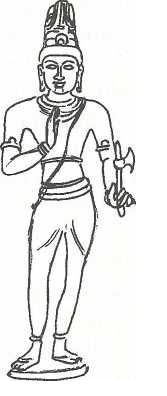Talk:Candesvara
Caṇḍeśvara He is one of the attendant deities of Siva. According to the mythological lore he was a brāhmaṇa boy, Vicāraśarman by name, who rose to that status by his intense devotion to Siva.
Iconographically, he is shown as a fierce deity, holding weapons of war and destruction like the bow, arrow, trident, chisel, noose and so on. Though inde¬pendent shrines dedicated to him are not uncommon, he is generally installed in every Siva temple in the north eastern corner, facing south. Devotees believe that he can act as a mediator interceding with the Lord on their behalf. Hence supplica¬tion before him is a duty of every devotee visiting a Siva temple. He is also known as Caṇḍi and Caṇḍeśa. Caṇḍeśvara (14th cent. A.D.) of Mithilā is a very important compiler of digests on dharmaśāstras. He was a minister as well as the chief justice at the court of the king Harisiriihadeva of Tirhut (now in Bihar). He belonged to the Karṇāta family. Smrtiratnākara or Ratnā- kara is the extensive digest compiled by him. Divided into seven sections—each containing the word ‘ratnākara’ as part of the title—it deals with kṛtya (what ought to be done), dāna (gifts), vyavahāra (judi¬cial procedure), śuddhi (purificatory rites), pujā (ritualistic worship), vivāda (dis- putes-civil and criminal laws) and gṛhas- tha (duties of householders). Krtyacintā- mani and Rājanitiratnākara are his other works considered important. Later writers on dharmaśāstras from Mithilā and Vaṅga (Bengal) have been greatly influenced by him.

